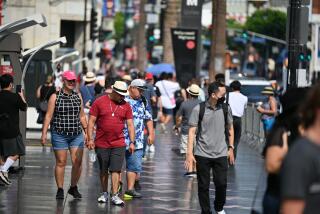Visitors’ Spending Rises to $444 Million : Tourism: Travelers spent 12% more than they had the previous year and 7,604 new jobs were created, a study for the Oxnard Convention and Visitors Bureau finds.
- Share via
Visitors spent more than $444 million in Ventura County in 1988, an increase of about 12% over the previous year, according to a report released Monday by the Oxnard Convention and Visitors Bureau.
The dollars spent in the county on food, clothes, recreation, hotels and fuel also helped generate 7,604 new jobs in 1988, an increase of almost 2% over 1987, the report says.
In 1987, visitors brought about $397 million to the county--an 11% increase over the previous year--and produced 7,478 jobs, according to the report from the marketing and research firm of Dean Runyan Associates of Portland, Ore.
The report defines visitors as people traveling through the county on business and pleasure.
The bulk of the money spent by visitors in 1988 went to eating and drinking establishments. In 1988, travelers spent more than $130 million on food and drinks in the county, the report says. The second largest share of travelers’ dollars went to retail stores, which received more than $116 million that year, the report said.
Hotels, motels and other accommodations brought in almost $70 million and produced 1,375 jobs, the report said.
Although the report did not calculate the money generated in each city, it did include local tax receipts from hotel and motel rentals in each. Such transient occupancy taxes are believed to be the most direct way for city’s to collect revenues from travelers.
According to the report, Ventura and Oxnard accommodations generated nearly 60% of the county’s transient occupancy tax revenues in 1988..
Ventura has a 10% occupancy tax and Oxnard’s is 9%. Ventura accommodations generated about $1.6 million in taxes and Oxnard’s produced $1.2 million, the report says. Thousand Oaks, which has a 10% occupancy tax, received about $1 million in revenues from its bed tax in 1988.
Although Camarillo has the lowest occupancy tax, with 5%, its accommodations generated about $304,000 in 1988, according to the report.
Robert D. Varley, executive director of the Oxnard Convention and Visitors Bureau, said the marketing firm was hired to give local government officials a better understanding of how business travel and tourism affects the county’s economy.
Varley said he hopes the report will impress upon Oxnard officials the importance of having a convention and visitors bureau to attract travel dollars to the city.
He noted that when the city adopts its 1990-91 budget next month, the City Council will consider eliminating its annual contribution of $395,856 to the bureau. Varley said that although the bureau gets revenue from other sources, such as membership fees, the bureau gets the bulk of its operating expense from the city.
Without the city contribution, the convention center would close, he said. “The city would lose more than it would gain,” he said.
Faced with a $2.7-million deficit next year, the council is considering a long list of possible budget cuts. However, city officials said the council has yet to recommend any specific budget cuts.
Although the report did not specify the amount of money generated in each city, Varley said the city of Oxnard generated the largest amount of tourism and business travel dollars, with $106 million.
According to his calculations, eating and drinking establishments in Oxnard brought in $31 million and retail sales attracted $27 million. Hotels, motels and other accommodations generated almost $17 million, he said.
The firm that prepared the report, Dean Runyan Associates, based many of its findings on an earlier report prepared for the California Department of Commerce and utilized many of the same data sources and calculating techniques, the report said.
More to Read
Sign up for The Wild
We’ll help you find the best places to hike, bike and run, as well as the perfect silent spots for meditation and yoga.
You may occasionally receive promotional content from the Los Angeles Times.







